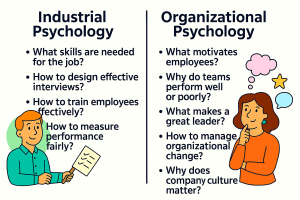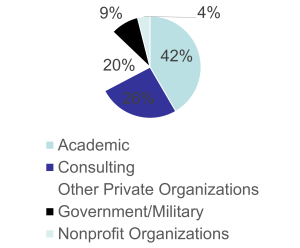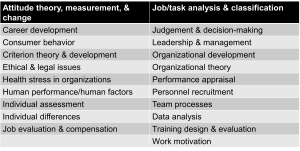1-1: What is I/O Psychology?

You walk into your favorite coffee shop, and everything runs like clockwork. Your order is taken quickly, the barista remembers your usual drink, and you’re out the door in minutes feeling good about the experience. Now imagine walking into another coffee place where the staff seems confused, your order gets messed up twice, and you leave frustrated and running late. What’s the difference between these two places? It’s not magic—it’s exactly the kind of workplace puzzle that Industrial and Organizational Psychology tackles every day.
You might be thinking, “I/O what now?” Don’t worry—most people haven’t heard of it. But here’s the thing: this field is essentially the science behind making work actually work for people. As Rogelberg (2007) puts it, industrial and organizational psychology “focuses the lens of psychological science on a key aspect of human life, namely, their work lives” with the goal “to better understand and optimize the effectiveness, health, and well-being of both individuals and organizations” (p. 1).
Think about it this way—you’re probably going to spend about 90,000 hours of your life at work. That’s roughly a third of your waking hours! Wouldn’t it be nice if those hours were spent doing something meaningful, with people you respect, in an environment that brings out your best? That’s exactly where I/O psychology comes in.
This field didn’t just appear overnight like some trendy startup. It grew out of necessity during the industrial revolution when people suddenly found themselves working in massive factories with hundreds of coworkers instead of alone on farms or in small shops. Someone had to figure out how to make this new way of working actually function without driving everyone crazy.
From those early days of trying to squeeze more productivity out of assembly line workers, I/O psychology has evolved into something much richer and more human-centered. Today’s I/O psychologists are like workplace detectives, using scientific methods to solve everything from “Why does our team keep missing deadlines?” to “How can we help people feel more engaged at work?”
What makes this field special is that it’s not just about theory—it’s about real solutions for real people. I/O psychologists don’t sit in ivory towers debating abstract concepts. They roll up their sleeves, collect data, test their ideas, and then help organizations implement what actually works. It’s psychology with a mission: making work better for everyone involved.
Understanding the Field

Industrial and organizational psychology is an applied discipline within psychology that studies people at work—how they think, feel, behave, and interact when they’re trying to get stuff done together (Spector, 2021). Internationally, this field goes by different names: occupational psychology in the United Kingdom, organisational psychology in Australia, South Africa and New Zealand, and work and organizational (WO) psychology throughout Europe and Brazil.
Here’s where it gets interesting: the field actually has two different personalities, and the names tell you everything you need to know.
Industrial Psychology: The Detail-Oriented Side
Industrial Psychology is the detail-oriented, practical side. These are the folks who get excited about questions like:
- What specific skills does someone need to be awesome at this job?
- How can we design interview questions that actually predict who’ll succeed?
- What’s the best way to train someone without boring them to death?
- How do we measure performance fairly without playing favorites?
Think of industrial psychology as the “matchmaking” side—it’s all about getting the right person into the right job and then helping them crush it once they’re there. These psychologists are like talent scouts who use science instead of gut feelings.
Organizational Psychology: The Big Picture View
Organizational Psychology zooms out to look at the bigger picture. These researchers tackle questions like:
- What actually motivates people to do their best work (hint: it’s not always money)?
- Why do some teams click while others fall apart?
- What separates great leaders from the ones who make people want to quit?
- How do you help an entire organization change without everything falling apart?
- Why does company culture matter so much, and how do you actually change it?
This side focuses on groups, relationships, and the invisible forces that shape how everyone behaves at work. If industrial psychology is about individuals, organizational psychology is about the social ecosystem they’re swimming in.
What Sets I/O Psychology Apart
You might be wondering—isn’t this just business management with fancy research methods? Not exactly. Here’s what sets I/O psychology apart from your typical MBA program:
Scientific Rigor
Instead of following the latest management fad or going with someone’s “brilliant” gut instinct, I/O psychologists actually test their ideas. They collect data, run experiments, and measure results. If something doesn’t work, they admit it and try something else.
People-First Perspective
While business schools often focus on profit margins and market share, I/O psychology puts human behavior at the center of everything. The assumption is that if you get the people part right, the business results will follow.
Individual Differences Matter
I/O psychologists know that people aren’t interchangeable parts. What motivates your coworker might completely demotivate you. What works in one culture might bomb in another. One size definitely doesn’t fit all.
Understanding the “Why”
Rather than just describing what people do at work, I/O psychology digs into why they do it. Understanding the psychology behind behavior gives you way more power to predict and influence what happens next.
The Scientist-Practitioner Model
Here’s something pretty unique about I/O psychology training—it follows what’s called the scientist-practitioner model. This isn’t as boring as it sounds, I promise.
I/O psychologists are trained to be both researchers and problem-solvers (Society for Industrial and Organizational Psychology, 2018). They can design studies and analyze data, but they can also walk into a chaotic workplace and figure out what’s actually going wrong and how to fix it. As an applied psychology field, the discipline involves both research and practice, and I/O psychologists apply psychological theories and principles to organizations and the individuals within them.
Why does this matter to you? Because it means:
- The people working on your organization’s problems actually understand research well enough to separate evidence-based solutions from snake oil
- The researchers studying workplace behavior stay connected to real problems instead of getting lost in academic rabbit holes
- Everyone contributes to advancing the field while solving actual challenges that affect real people
The professional identity of I/O psychologists has evolved significantly, especially with the formation of APA Division 14 (SIOP) in 1946, which formalized the field’s role within psychology. One ongoing debate is around licensing, as I/O psychologists typically don’t engage in clinical practice, raising questions about the necessity and relevance of licensure for professionals focused on organizational consulting and research.
Most I/O psychologists belong to the Society for Industrial and Organizational Psychology (SIOP), which sets training standards, promotes ethical practice, and keeps academics connected with practitioners. Think of it as the professional home base for everyone in the field. I/O psychology is one of the 17 recognized professional specialties by the American Psychological Association (APA), and in the United States the profession is represented by Division 14 of the APA and is formally known as SIOP.

Where Do These People Actually Work?
The career paths are more diverse than you might expect. According to recent employment data, I/O psychologists work across various sectors:
- 42% work as university professors, conducting research and training the next generation
- 26% work for consulting firms, helping multiple organizations solve their people problems
- 20% work inside companies as internal consultants and strategic advisors
- 9% work in government, applying I/O principles to public sector challenges
- 4% work for nonprofits, often focusing on mission-driven organizations
The field shows strong employment prospects, with the U.S. Bureau of Labor Statistics reporting that I/O psychologists earned a median annual salary of $147,420 in 2023, and employment is expected to grow by 6% through 2033 (U.S. Bureau of Labor Statistics, 2024). According to SIOP, I/O psychologists’ job demand and growth are expected to grow by 12.8% through 2028.
What do they actually do all day? Here are the main areas:
Selection: Creating better ways to identify and hire people who’ll actually succeed and be happy in the role
Training: Designing learning experiences that actually stick and help people grow their capabilities
Organizational Development: Helping entire organizations become more effective, adaptive, and humane
Performance Management: Building systems that fairly evaluate and improve performance without crushing people’s souls
Quality of Work-Life: Making work more satisfying, meaningful, and less likely to burn people out
Human Factors: Designing workplaces and technology that work with human capabilities instead of against them

Media Attributions
- Students Working © Unknown is licensed under a Public Domain license
- Industrial vs. Organizational Psychology © Jay Brown & Copilot
- Where Do I/O Psychologists Work adapted by Jay Brown
- What Do I/O Psyschologists Do?
